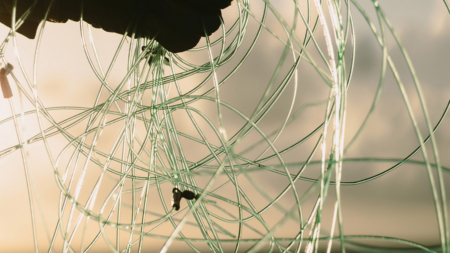The Darkest Web
Protecting the Gulf of Mexico from illegal fishing.
We wear bulky bulletproof flak jackets, and there are shouldered semi-automatic carbines and holstered 9mm pistols. I am not comfortable with any of this. I am a pacificist to my very core, and being surrounded by these menacing weapons in a place I retreat to for peace is unnerving. This is everything I love and live for in a head-on clash with the laws and mandates of who gets what.
I am south of the Padre Island National Seashore, where aquatic wildlife netting and smuggling runs rampant. I’m setting out to traverse the entire Texas coastline, from the Mexico border northward to Louisiana. This is a journey to understand the complex peril facing the Gulf ecosystem—an area that’s about 600,000 square miles. Some of us have taken from her far more than she is capable of giving.
Rivers shouldn’t be borders. They are here to bring us together—to carry us places. For some, they are lines in the sand, but I’ve always known this earth is for all of us to share. Here along my home coast, just a few minutes before 5 a.m., I step onto a shallow-water jet boat in the darkness. Three armed Texas game wardens nod good mornings. I breathe in the Rio Grande’s pungent mix of salt and mud, along with the sweet smell of driftwood smoke coming from the fish-camp breakfast fires 100 feet away in Mexico.
As the boat motor fires and we head up the Rio Grande, we scan for illegal nets on the American side, which trap wild snook, tarpon and redfish in the critical estuary they use for spawning before making their way to the sea. A close friend and fellow fly angler has been a Texas game warden for years. He’s arranged it so I can ride along on their patrol and share time with those who have devoted themselves to preserving the ecosystem.
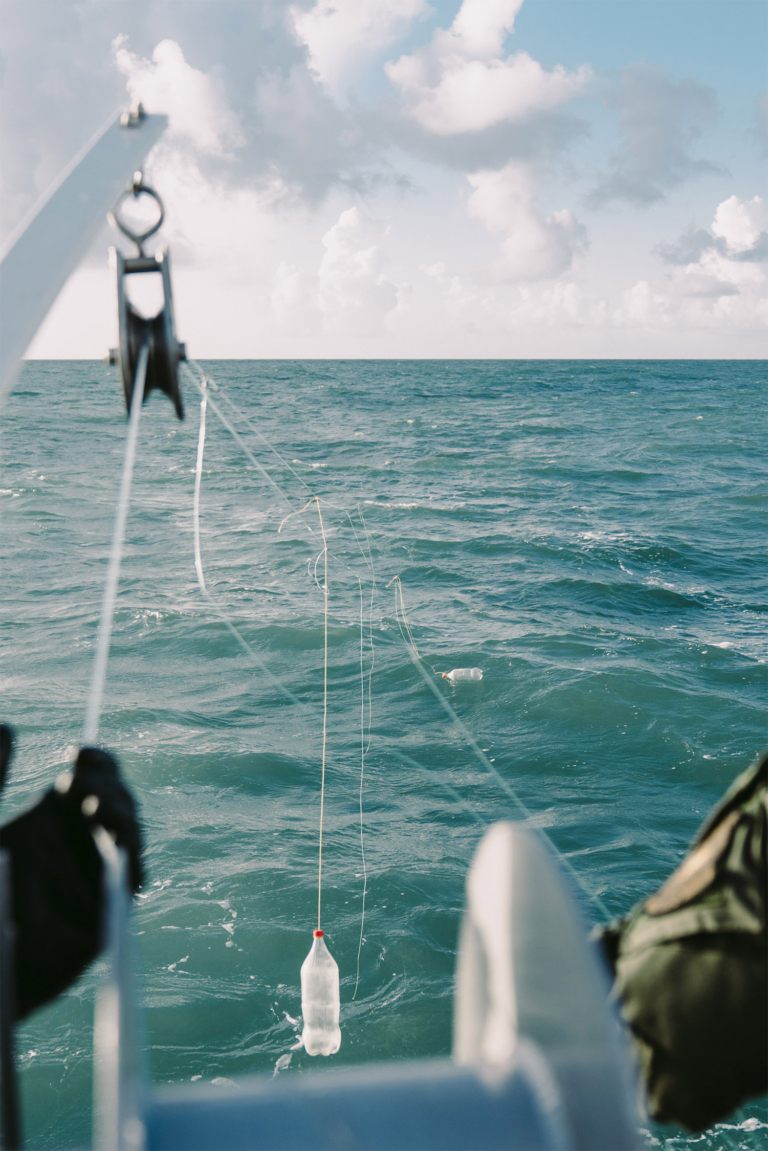
Plastic bottles are used as floats for illegal nets and longlines. These devices kill everything unlucky enough to cross their path: including dolphins, sea turtles, tarpon, redfish, mackerel and sharks alike. Photo: Tony Czech
As the first tendrils of light make their way into the sky, I begin to see the sinuous oxbows and pathways of the river, along with the free-roaming wild mustangs who come down to cool their thirst on the grassy banks. I admire their lean bodies, sandy golden and auburn.
At midmorning, I reach over the boat gunwale to pull out one-liter plastic bottles serving as floats marking an illegal net. There is the translucent shimmer of fish. From the palm of my hand I am able to free a struggling baby snook. It’s fragile and desperate. The other fish—redfish, catfish, jacks, baitfish—aren’t so lucky.

The author accompanies Texas game wardens on an early-morning patrol of the Rio Grande. Photo: Tony Czech
On the river’s banks I see telltale prints from bare feet in the sand. Some of them are tiny. They lead to pathways in the brush that have been knocked down by humans rolling the dice to risk it all crossing to our country, dreaming of a better life.
By late afternoon, we have made our way up 10 miles of the Rio Grande and back, returning to where the river’s mouth empties into the gulf at Boca Chica. In a winter storm years ago, I once surfed here alone and remember that before paddling out, I found an eight-foot bull shark that had washed up on the beach—a massive bite ripped from its stomach.
The beach sands and water this close to Mexico are a beautiful, heady blend of ceruleans and aquamarines—although no one is honeymooning here. To the south is another slew of Mexican fish camps, consisting of small open tents and ramshackle shelters. To the north is the base for SpaceX, surrounded by miles of fences and security. The opulence of interstellar exploration adjacent to poverty and survival mode, all just feet from each other.
The wardens shoot the breeze and busy themselves with trailering the boat. They are soft-spoken, no-bullshit, salt-of-the-earth Texans. They are not only responsible for wildlife and public lands but also domestic disputes, human trafficking, confrontations with drug runners and more. They seem used to it. A late lunch of tacos al carbon refuels the team before they’re back on the road to the next mission. They wish me well, and we make plans for tomorrow’s patrol.
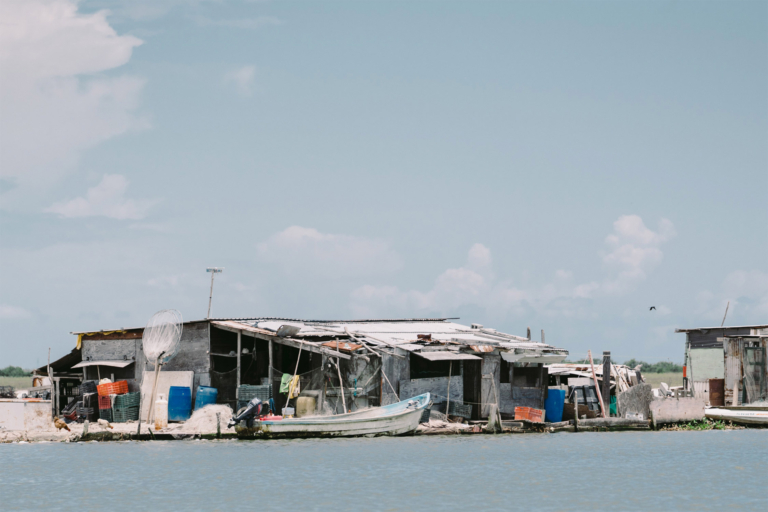
This fishing camp is located in Mexico, near the mouth of the Rio Grande. Photo: Tony Czech
3 a.m. I can’t sleep. I’m in a bunk at the warden’s boat barn. I simmer water for coffee in the small kitchen, thinking about the tangle of bewildering issues at hand. I read through notes from the hours of discussions with marine biologists. I pour boiling water over the grounds. A scorpion is curled up in the ceramic mug I left out on the counter. I take it outside and set it free in the nearby bushes. It means everything to me to save what I can in this life—even things I am afraid of or don’t understand.
The gulf coast of Texas spans some 330 miles, and the international boundaries are clear. Backed by Mexican cartels, foreign vessels have been crossing this border daily, setting miles of illegal gill nets and longlines—suspended fishing leads with multiple baited hooks in sequence—to capture fish. The longlines and nets indiscriminately capture and kill dolphins, sea turtles, tarpon, redfish, mackerel, sharks and so many other beautiful creatures. Biologists estimate that the number of fish taken is up to three times what the state deems sustainable for the marine ecosystem. The cartels then smuggle the fish across the border and sell them back to Americans.
There are also boats finning sharks and sending them to restaurants across the country and all the way to Asia. The wardens have made many undercover busts but keeping up with all of the darkness at hand seems challenging, at best. Not to mention the fact that the market for dried and powdered seahorse is strong, bringing a few hundred dollars per pound. This is appalling. How is this happening? How many seahorses must be killed to make a pound of aphrodisiac?

Aboard this 80-foot, hydrofoil-assisted long-range patrol ship, Texas game wardens retrieved a longline that stretched for four miles. Photo: Tony Czech
This gulf ecosystem is as miraculous and impeccably balanced a design as one could ever dream up. We have five endangered and threatened species of sea turtles here that, just like wild salmon, travel thousands of miles to lay eggs in the same sand where they were born. Inch by inch, tiny hatchlings fight their way to the sea, surviving countless predators and obstacles only for an illegal net to take away their light. The bottom line is the same as it ever was—we can’t eliminate everything, from our apex predators down to the tiniest of beings, and expect them to be there anymore. Everything falls apart.
A couple of minutes before sunrise, I stow gear in a cargo hold of an 80-foot, hydrofoil-assisted long-range ship while the wardens throw bowlines and batten down the hatches. The diesel motors remind me of farm tractors humming by the bass lakes I fish near my home in Houston. I hear the Coast Guard airplane pilots radio-in to touch base for the day and update everyone on which vessels in the area are most likely setting or retrieving illicit longlines. Everything seems both familiar and foreign, for I know water more intimately than anything else in my life. Still, usually, it is from the canoe or up to my hips wading, not an imposing vessel stuffed with high-tech surveillance equipment and automatic weapons.
By late daybreak, miles out into the gulf, the search team spots what looks to be buoy markers for longlines. I’ve been wondering if we would see anything since the gulf seems as vast as can be imagined. The team gets to work preparing for the buoys as the ship’s bow door drops, and a device to secure the longline is set into motion. I’m asked if I want to be the one who starts pulling it in. I lean over the steel rails and take hold of what feels like the whole world, digging my boots into the deck to haul back the killing machine, hand over hand.
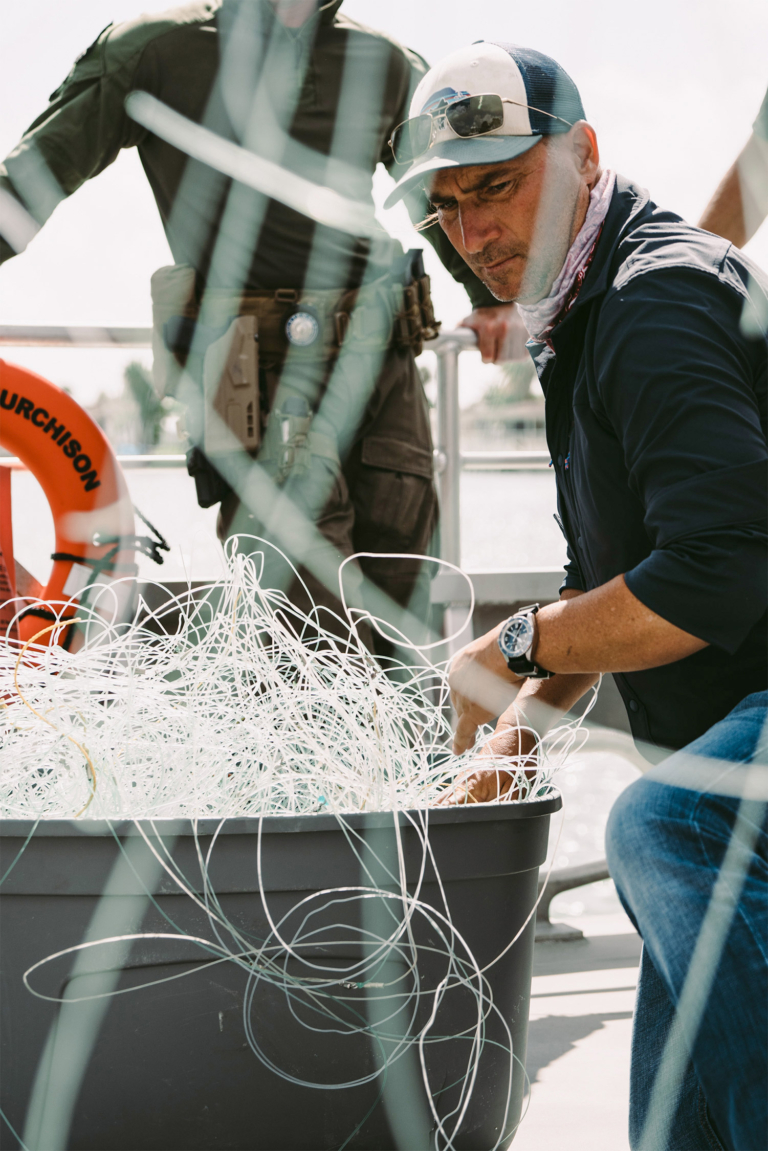
Illegal longlines are fishing lines with multiple baited hooks running in series and suspended by floats or plastic bottles. Biologists estimate that the number of fish taken in the Gulf is up to three times what the state deems sustainable for the marine ecosystem. Photo: Tony Czech
Within seconds, the first fish come into sight. They slowly appear from the emerald depths, spinning in circles as they rise. The line feels alive in my hands, thanks to everything attached, along with the buck and heave of the seas. I count sharks, silver king mackerels with turquoise flanks and fish after fish from a line that reaches the horizon. I pray I don’t see any dolphins. I am not prepared for that. Most of the fish have been dead for days, having been left out here for who knows how long. The few that have made it are released as quickly as I can. The deck is filled with wasted life. It takes hours to get everything in. The line is four miles long.
The afternoon proceeds like an action movie, but it’s shockingly real. Sirens from the ship tower begin blaring, and the motors redline. It is an absolutely gonzo and harrowing full-speed chase after an illegal panga filled with nets and fish. I watch with a white-knuckle perspective as the fleeing boat risks going ass over end to try and make it back across the border before the wardens can catch them. Guns are shouldered, and the gravity of the moment is shockingly real, with the possibility of us taking fire from them. Wave conditions are so unruly we can’t deploy the ultra-fast chase skiff. They escape.
Not a word is spoken. Shoulders are squared, and lookout stations are crewed again—just another day at the office. The cat and mouse between the wardens and the poachers is never-ending. The poachers hope to catch as many fish as they can and make it back across international lines. The wardens hope to stop the poachers and make it home to their families for supper.
Eventually, the seas become too high to travel safely, and we head for home, hoping to make it before the tide changes. After goodbyes and thanks to the captain, I load the truck and head back up the coast, five hours toward Galveston. Before I leave, the commander hands me a small slip of paper with an address.

In a climate-controlled Texas warehouse, illegally harvested shark fins are held as evidence in an illegal fishing trial. This single case included close to 900 fins. Photo: Tony Czech
My hands are full, overflowing with heartbreak. I have gently placed close to 900 shark fins on the ground at my feet to fully comprehend the depths of what is taking place. In a non-descript, climate-controlled warehouse in a quiet neighborhood near the city of Baytown, these fins are now what the state of Texas classifies as “evidence.” Awaiting their day in court, these fins are from a single bust. This shakes me to the core. Having surfed oceans around the world for much of my life, I both respect and cherish sharks. They are the gatekeepers of the ocean’s balance.
Some of the fins are so large I am barely able to hold them against my breastbone. I can picture each of them gliding through the sea. I imagine the knives coming from the sides of pangas—again and again. I ache for all that has happened and all that will happen if we don’t create change. This is how we treat our wild, beautiful creatures in this world? From majestic and regal to a bowl of soup thousands of miles from here. After the court case, these fins will be destroyed.
As a child, I would play a game where I would whirl around in the yard with eyes closed and my arms out. Dizzy as can be, I would try to run in a straight line. I never got more than a few steps before crashing to the grass, buckled at the knees and with all sense of equilibrium gone. In this warehouse, I feel the same. I’ve come to understand how I am wired and know that when my belief in humanity and hopes and dreams for this life become momentarily unrecognizable, in lieu of anger, shouting or struggling for emotional control, I choose the opposite. I go quiet.
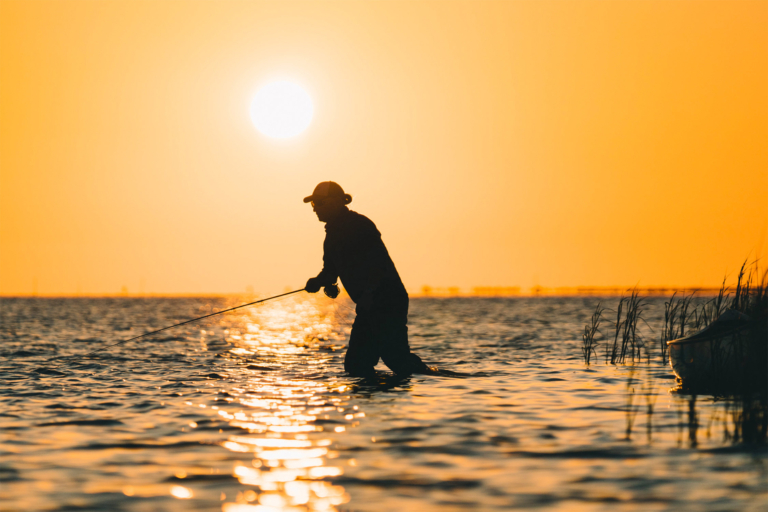
After a harrowing experience confronting the scourge of illegal netting in the Gulf of Mexico, the author returns to quieter waters—a remote salt marsh brimming with life along the Texas-Louisiana border. Photo: Tony Czech
Sometimes we have to lose ourselves to find ourselves. I’m compelled to escape to the sea to check the pulse of the earth and myself. Most importantly, after all I’ve witnessed, to recalibrate a heart that beats in time with these waters.
The darkness is almost gone. At 5:22 a.m. I place a weathered thunderbird blanket, some clothes, a fly rod, firewood and food for a few days into the canoe. Savoring a second cup of coffee from the battered thermos, I sit on the gunwale attempting to make peace with everything that has happened the last couple of days. I’m on the Texas-Louisiana border along the edges of a favorite marsh. Hours away, the rest of the world is awash in the tumult of concrete highways and doom-and-gloom news cycles. And here in front of me is this—the solitude and restorative tranquility of wilderness.
I push away from the sandbar and begin making my way deep into the outer fringes for a few days. There is no other way possible to get where I am going other than by canoe. This early, it’s whisper calm and windless. The water is without a ripple. For now, this coast is aflame with life. There are multitudes of tiny crabs scampering along exposed oyster beds thanks to the low tide, while pink fledgling shrimp are chased by redfish and flounder. Mullets arc into the air, afraid of the slightest upheaval. The marsh grasses are filled with the nests of egrets, herons, cranes and roseate spoonbills. Out here, there are many types of wings.
This water is sea glass. Within the fragile membrane of it all, we are able to see a reflection deep inside ourselves—and our behaviors. It shines a light on the consequences of human actions. When some take more than the sea can offer, we all lose. I don’t know anything other than this simple truth: We are all capable of so much better than this.
Protect the Gulf of Mexico
Due to overfishing, habitat loss and industrial impacts, many Gulf species are at risk. The sperm whale, Gulf of Mexico Bryde’s whale, West Indian manatee and all five species of Gulf sea turtles are listed as threatened or endangered.
Based in New Orleans, LA, Healthy Gulf’s mission across all five Gulf states is to collaborate with and serve communities who love the Gulf of Mexico by providing the research, communications and coalition-building tools needed to reverse the long pattern of overexploitation of the Gulf’s natural resources.
